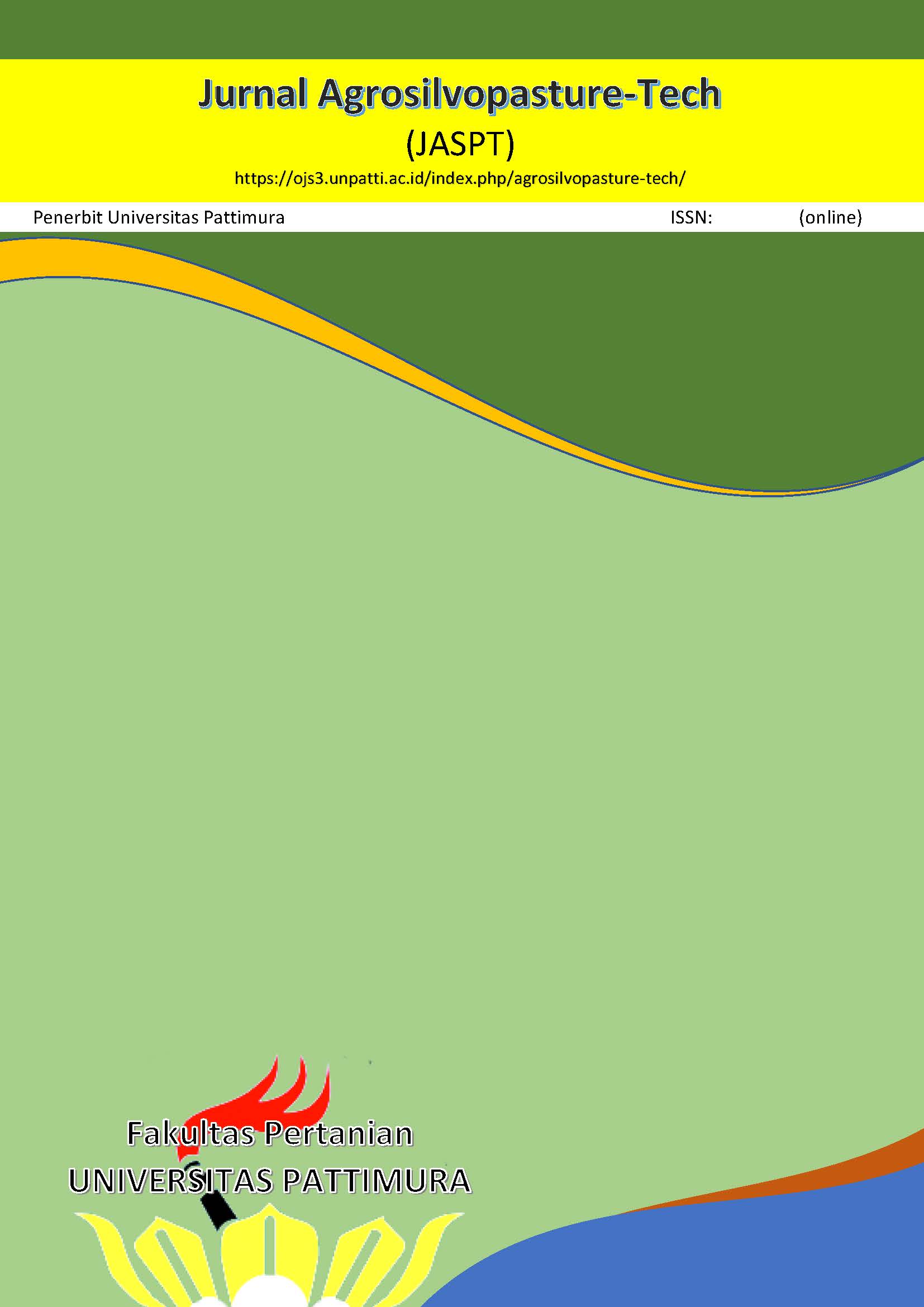Analysis of Physical and Chemical Properties of Eucalyptus Oil in Suli Vilage, Salahutu Sub–District, Central Maluku District
Abstract
The purpose of this study was to determine the effect of leaf weight and storage time of eucalyptus leaves on yield, seniol content, specific gravity, refractive index, and optical rotation. This study used a factorial randomized block design with 2 factors, namely: treatment A (leaf weight) with 3 levels of treatment, namely: A1 = 3000 g A2 = 4000 g A3 = 5000 g, and factor B (storage time) with 3 levels of treatment B1 = 2 days of storage B2 = 4 days of storage B3 = 6 days of storage. Based on the results of the study, the yield of eucalyptus oil ranged from 0.44% - 0.94%, and the cineol content of eucalyptus oil was 46.7%-52.7%. The specific gravity of eucalyptus oil is 0.91%–0.93%. The optimal rotation of eucalyptus oil ranged from -2.16 to -3.94. Based on the Indonesian National Standard SNI 06-3954-2001, the physicochemical properties of eucalyptus oil, namely cineol content, specific gravity, refractive index, optical rotation, and solubility in ethanol 80% have values that meet SNI 06-3954-2001.
Downloads
References
Arnita, P. (2011). Pengaruh varietas dan kerapatan daun kayu putih (Melaleuca leucadendron Lin). Dalam ketel rendemen dan mutu minyak kayu putih, skripsi bogor; Departemen Hasil Hutan Institut Pertanian. Tidak Dipublikasikan
Aryani, F. (2020). Penyulingan Minyak Kayu Putih (Melaleuca cajuputi) dengan suhu berbeda. Buletin LOUPE, 16(02).
Guenther E. 1987. Minyak Atsiri. Volume ke-1. Ketaren S, penerjemah: Jakarta: Universitas Indonesia Press. Terjemahan dari: Essential Oil.
James, E.F.R. (Ed). (1989). Martindale the Extra Pharmacopoeia 29th Ed. The Pharmaceutical Press. London.
Ketaren, S. 1985. Pengantar Teknologi Minyak Atsiri. Jakarta: Balai Pustaka. Kasmudjo. 1982. Dasar- Dasar Pengelohan Minyak Kayu Putih. Yayasan Penerbit Fakultas Kehutanan UGM. Yogyakarta.
Nurramdhan, I.F. (2010). Daya Hambat Minyak Kayu Putih dan Komponen Penyusun Flavor Cajuput Candy Terhadap Akumulasi Biofilm Streptococcus mutans dan Streptococcus sobrinus secara In Vitro. [Skripsi]. Bogor: Fakultas Teknologi Pertanian, Institut Pertanian Bogor.
Soepardi, R. (1953). Perusahaan Minyak Kayu Putih. Vol II. Jakarta: Rimba Indoonesia.
Sumardiwangsa, S. (1973). Pedoman Pengujian Kualitas Minyak Kayu Putih. Publikasi Khusus No.14. Bogor: Lembaga Penelitian Hasil Hutan.
Sumardiwangsa, S. (1976). Teknik Pengolahan dan Kualitas Minyak Kayu Putih. Publikasi Khusus No.67. Bogor: Lembaga Penelitian Hasil Hutan.
Sumardiwangsa, S. (1983). Penetapan Kualitas Minyak Kayu Putih MetodeKristalisasi. Bogor: Lembaga Penelitian Hasil Hutan.
Sunanto, H. (2003). Budi Daya Dan Penyulingan Kayu Putih. Yogyakarta: Kanisius Pemerintah Negeri Suli, 2019, Profil Negeri Suli (tidak diterbitkan).
Winara, A., Siarudin, M., Indrajaya, Y., Junaidi, E., & Widiyanto, A. (2012). Kajian Potensi Minyak Kayu Putih Di Tanam Nasional Wasur Papua. LaporanAkhir Kegiatan Insentif Peningkatan Kemampuan Peneliti dan Perekayasa. Kementerian Riset dan Teknologi.
Copyright (c) 2023 The Author(s)

This work is licensed under a Creative Commons Attribution-ShareAlike 4.0 International License.




.png)

